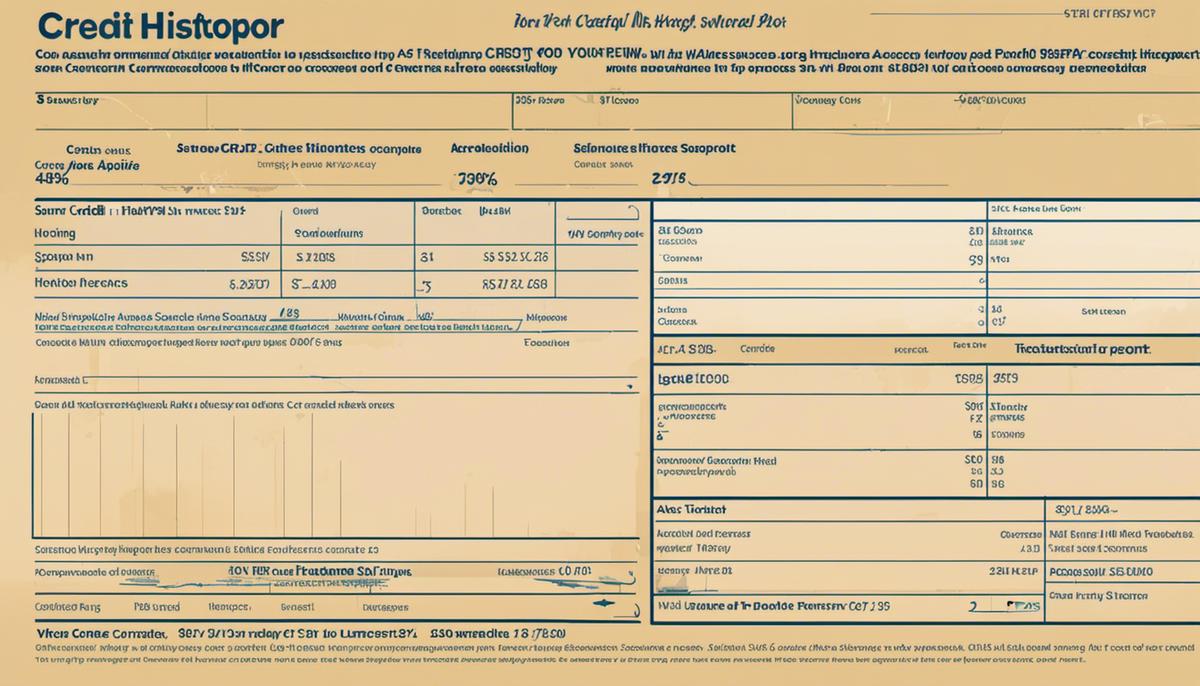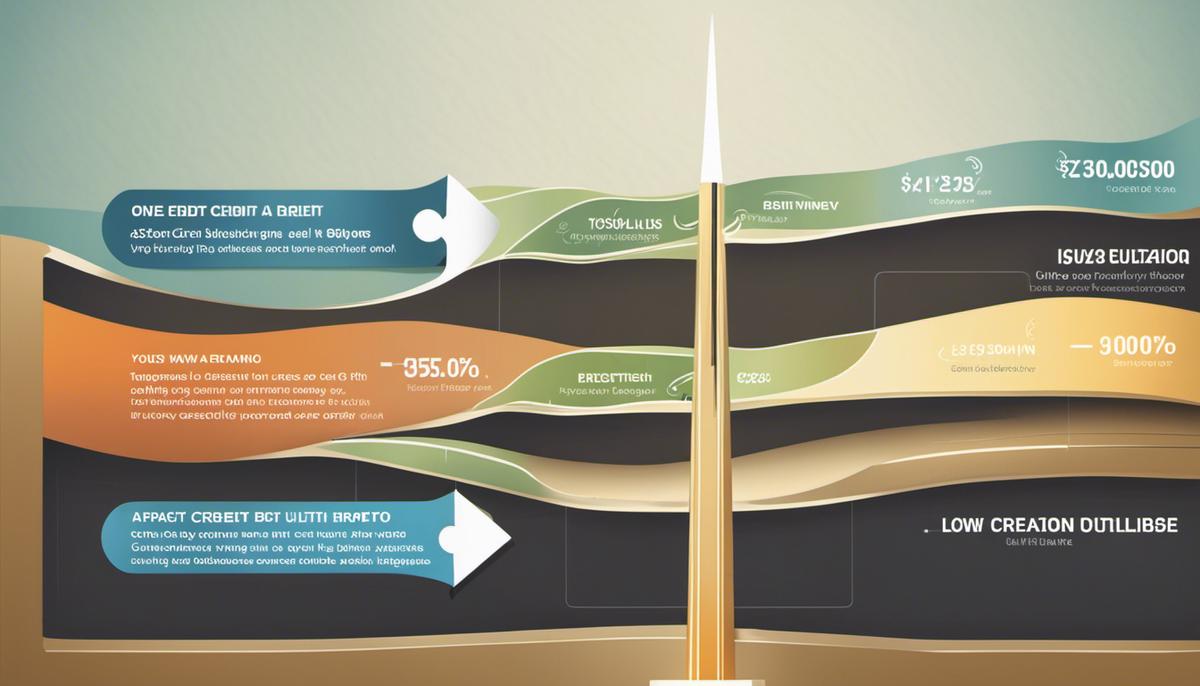Entering into the financial world can feel like navigating through an unpredictable maze. An essential element of this journey involves understanding one’s credit score and knowing how to build a good one. In your financial life, your credit score can influence many aspects including your ability to secure competitive loan rates, certain jobs, housing, and more. As such, establishing a credit history, maintaining a low credit utilization ratio, and consistent, timely bill payments are vital parts of this process. They are foundational tasks that, when done correctly, contribute substantially to a high credit score reflecting your financial health and responsibility.
Table of Contents
Establishing Credit History
The Significance of Credit History in Sculpting a Robust Credit Score
A number often deemed as simply three digits, but its significance is nothing less than the lifeblood of financial stability in the modern business ecosystem – yes, we’re talking about the credit score. This pivotal element serves as a quantifiable metric of trust. As the business and finance realm continues to evolve, this pivotal piece of the financial puzzle has become increasingly critical.
Understanding the Linchpin: Credit History
Simply put, the credit history is a comprehensive record of your borrowing activities and repayments. It’s the lifelong financial report card that lending entities, like banks and credit card companies, use to assess your ability to repay future debts. Over time, this history shapes the credit score. Essentially, it’s the chronological blueprint upon which your credit reputation stands.
The Nurturing Symbiosis
Just like the symbiotic relationship between bees and flowers, establishing a good credit history and building a high credit score are bound by a similar synergy. The former feeds into the latter. By making good on time payments and keeping the credit utilization ratio low, we can establish a reliable credit history, which in turn paves the way for an excellent credit score.
The Golden Rule of Credit Utilization Ratio
A tipping point when it comes to credit history is managing the credit utilization ratio. This ratio, representing the balance you owe versus your total available credit, plays a considerable role in boosting or bruising your credit score. Business mavens will tell you – ideally, keep this ratio below 30%. The lower, the better.
Transforming Good to Exceptional: Diversified Credit
While maintaining an impeccable repayment schedule is crucial, sprinkling your credit portfolio with a mix of credit types – credit cards, installment loans, retail accounts, etc., adds a layer of reliability to your credit history. Such diversity in credit is seen as a sign of responsible financial management, adding brilliance to your credit score.
Late Payments: The Dent in the Armor
Late payments, even if by a day or two, no matter how rare, are like black spots on the moon’s surface. They tarnish the sheen of your credit history and drag down your credit score. In the world of credit scores, good habits are quickly rewarded, but bad habits have a far longer memory.
The Bottom-Line: Building A Foundation for Prosperity
When you look at some of the most financially savvy individuals and thriving businesses, you can almost guarantee they share mutual respect for one thing – a hearty credit score. That being said, establishing a good credit history isn’t just about the numbers; it’s about the journey to financial maturity, a platform of prosperity and the key to financial doors. Business moguls know – racking up a consistent, positive credit history is the road to building a prodigious credit score. Forge yours diligently, and reap the fruits of financial trust and freedom. Here’s to your journey!

Maintaining a Low Credit Utilization Ratio
The Impact of a Low Credit Utilization Ratio on Your Credit Score
The nature and impact of credit utilization can often be overlooked when building a credit history, but it’s an essential component of maximizing your credit score for solid financial opportunities. It’s pivotal to comprehend the intricacies of credit utilization ratio, particularly how a lower rate can positively impact your credit score.
Essentially, the credit utilization ratio is the calculation of the total amount of credit used relative to credit available. Striving to maintain a low credit utilization ratio is vital because a lower ratio indicates a more prudent borrowing behavior to potential creditors. Experts suggest maintaining a credit utilization ratio below 30%, but one could reasonably argue that an even lower percentage would be even more beneficial.
Interestingly, the credit utilization ratio surprisingly accounts for a whopping 30% of your FICO score calculation. This means keeping a low credit utilization ratio can significantly improve your credit score, thus providing you with improved financial possibilities. A low ratio suggests to creditors that you’re fiscally responsible and far less likely to default on loans or payments.
In the macro perspective of all industries, the low credit utilization ratio is particularly advantageous in mortgage applications. Mortgage companies and lending institutions prefer to deal with applicants who have proven their financial responsibility by effectively managing their credit. Therefore, a low credit utilization ratio can facilitate your way towards a successful mortgage application, proving you as less of a risk to lending institutions.
In business, credit flexibility is critical for opportunities and growth. Achieving a low credit utilization ratio can unlock an array of financial possibilities, allowing businesses to scale efficiently and strategically. For instance, a low ratio can provide benefits like higher credit limits or better interest rates, which can provide improved liquidity and flexibility for business transactions.
On the personal level, strong credit scores backed by low credit utilization ratios make it possible to secure competitive rates on auto loans, credit cards, and other types of consumer debt. This can translate to thousands of dollars in savings over the lifetime of these loans, all thanks to the smart management of credit utilization.
Remember, managing your credit utilization ratio isn’t a one-time task. It’s a continued practice that you should incorporate into your financial habits. Regularly monitor your credit balance, and ensure your ratio remains low, especially if you’re looking to make a significant financial transaction like buying a house or starting a business.
To sum it up, as you navigate the financial landscape amid fast-paced business and economic trends, ensuring a low credit utilization ratio is not just a nice-to-have, but rather a quintessential strategy that determines your financial health and agility in the market. Embrace this component as part of your credit management, and watch as it paves the way for a fortified credit score and a host of financial opportunities.

Paying Bills on Time
Switch gears for a moment and consider the undeniable impact of timely bill payment on achieving a strong, healthy credit score.
While credit history undoubtedly plays an integral part in shaping your creditworthiness, it’s just the tip of the iceberg. A financial powerhouse always has the next move in mind, and it’s more than understanding the link between a low credit utilization ratio and a high credit score.
Bill payment is the unsung hero of the credit score scene, delivering profound benefits for individuals who consistently make their payments on time. These may seem like minor financial decisions, but every timely bill payment contributes to a stronger credit score and boosts your reputation as a responsible borrower.
Let’s take a closer look at the influence of bill payment on your credit status. Payment history carries the largest weight in credit score calculations. In fact, it represents a staggering 35 percent of the FICO Score determination. FICO, the most common type of credit score, places significant emphasis on your ability and willingness to fulfill your payment obligations.
Now, you might wonder why this is so important. Imagine yourself as a potential lender: wouldn’t you want to know if a borrower faithfully meets payment deadlines? Your consistent bill payments serve as reassurance to lenders that you’re likely to repay your debt obligations in a timely fashion.
In some cases, businesses or service providers may report your account to the credit bureaus if you continuously make late payments. These remarks can stay on your credit report for up to seven years, potentially tanking your credit score and making it more difficult to secure financial opportunities in the future.
Through a network of credit and financial industry contacts, business savants understand the impact of current, less significant payments—like utility and phone bills—on a credit score and potential lenders’ decision-making processes. Often overlooked, these smaller payments are becoming increasingly pertinent in credit evaluations. Their timely payment can give your credit score an incremental, but substantial, boost.
So, exactly how can you leverage this knowledge to your advantage? It starts with a proactive approach. Don’t wait for bill payments to become overdue; set reminders and pay them promptly. Consider using automatic payment plans where possible. This serves a dual purpose: it guarantees timely payments and keeps your available credit in check, further improving your credit score.
Remember, no single factor in isolation will translate into a glittering credit score. It’s a blend of factors—on-time bill payments, a healthy credit utilization ratio, diverse credit types, and an established credit history. Innovation and evolution are key tenets of a successful entrepreneur, and they apply here too. Adapt your financial management strategies accordingly, and watch your credit score soar.
In the competitive financial market, attention to billing cycles, prompt payment of due amounts, and cautionary steps to avoid late payments can ensure a progressive journey towards improved credit score. As we change industries, we must recognize this approach as not just a financial best practice, but a business imperative towards financial wellness and opportunities.

Once you have started building your credit, it’s important to monitor and control your financial situations regularly. This will maintain the healthy credit history, low credit utilization ratio, timely payments, and other elements your credit score represents. Building and maintaining a good credit score doesn’t happen overnight, so it’s essential to be patient and persistent. Remember, a good credit score is not simply a status symbol; it opens doors to many financial opportunities, making your life easier and more secure in the long run. By following these outlined steps, every individual can build a good credit score, ensure their financial stability, and enjoy the benefits it presents.

Lian Jadepeak is a Chartered Financial Analyst (CFA) with a sharp acumen for investment strategies and financial markets. With a background in finance and years of experience in wealth management, Lian offers readers expert insights into smart investing, market trends, and portfolio management. Her clear, analytical approach helps demystify complex investment concepts for both seasoned and novice investors alike.


Valuable info. Fortunate me I discovered your site accidentally, and I am shocked why this accident didn’t took place in advance! I bookmarked it.